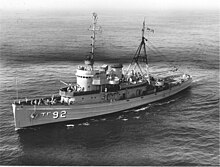 USS Cree (ATF-84) underway in 1970
| |
| Class overview | |
|---|---|
| Builders |
|
| Operators | |
| Preceded by | Bagaduce class |
| Succeeded by | Abnaki class |
| Built | 1938–1943 |
| In service | 1940–1994 (US) |
| Completed | 29 |
| Active | 4 |
| Lost | 4 |
| General characteristics | |
| Type | Fleet tugboat |
| Displacement | 1,235 long tons (1,255 t) |
| Length | 205 ft (62 m) |
| Beam | 38 ft 6 in (11.73 m) |
| Draft | 18 ft (5.5 m) |
| Propulsion | Diesel-electric, 1 shaft, 3,600 hp (2,685 kW) [1] |
| Speed | 16.5 knots (30.6 km/h; 19.0 mph) |
| Complement | 85+ |
| Armament |
|
The Cherokee class of fleet tugboats, originally known as the Navajo class, were built for the United States Navy prior to the start of World War II.[2] They represented a radical departure from previous ocean-going tug designs, and were far more capable of extended open ocean travel than their predecessors. This was due in large part to their length of 205 feet (62 m), 38 feet (12 m) beam, and substantial fuel-carrying capacity. They were also the first large surface vessels in the United States Navy to be equipped with Diesel-electric drive.[2]


The first three vessels, Navajo, Seminole and Cherokee, were constructed from 1938 to 1940 at the Bethlehem Staten Island division of Bethlehem Steel. Navajo and Seminole joined the Pacific fleet in 1940, and Cherokee went to the Atlantic fleet. Navajo was en route to San Diego from Pearl Harbor on 7 December 1941, and immediately reversed course to Pearl Harbor once news broke of the Japanese attack. She became a critical element of salvage operations there, as did her sister ship Seminole, in the days following the attack.
Following the loss during World War II of the first two ships of the class, Navajo and Seminole, the class was renamed from its original pre-war name of Navajo class to Cherokee class, the name of the third ship laid in 1939, which still survived.[3]
- ^ "Huge Diesel Electric Tugs Attend Fleet At Sea" Popular Mechanics, December 1940
- ^ a b "Navajo class". Uboat.net. Retrieved 22 July 2015.
- ^ Polmar, Norman (2005). The Naval Institute Guide To The Ships And Aircraft Of The U.S. Fleet (18th ed.). Annapolis, Maryland: United States Naval Institute. p. 282. ISBN 978-1591146858.